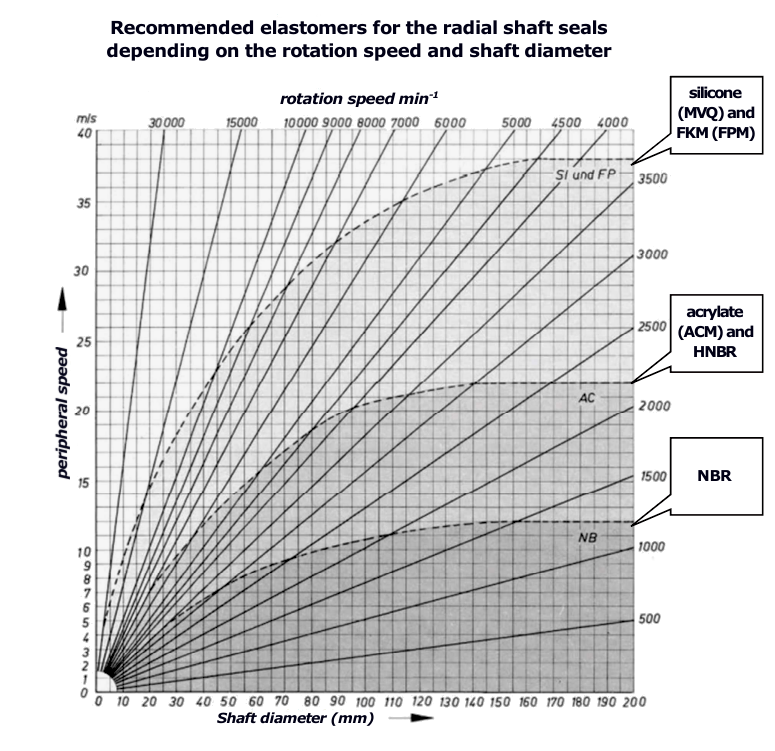Most of the shaft seals we produce are first installed (OEM), but unfortunately we regularly find that even here the installation conditions are still not satisfactory. Our experience is even worse when it comes to replacement parts, although these shaft seals will have to stand up to even more demanding conditions. Therefore, we will briefly summarise what is required by the EU DIN 3760 standard and practice.
Choose the right material!
NBR can be used at temperatures up to 100°C, but not even then. See: KTT NBR shaft seals.
FKM can be used up to 200°C, but it is good to know that the rotating shaft near the sealing edge increases the actual temperature by 10-30°C depending on the radial clamping force, the rotation speed, the coefficient of friction and the heat dissipation conditions. See: KTT FKM shaft seals.
FKM, as the "rubber version" of PTFE, is the elastomer with the lowest coefficient of friction.
NBR is good with gear oils and engine oils, but for gasoline, FKM is the material of choice and is the most chemical resistant rubber. Silicone can be used up to 180°C and is flexible at -50°C, but is no longer recommended for diesel oil.
Use our shaft diameter - speed nomogram! Overstressed in thermal load, a built-up shaft seals is hard at the edge, often cracked radially. In such cases, switch to a higher material grade.
Use the nomogram for rotation speed – shaft diameter!
If the heat and chemical resistance of FKM is not sufficient, PTFE with metal housing is the right solution. See: type B2PT.
When fitting, it is important that both the shaft to be sealed and the bore of the sealing ring are provided with a suitable conical groove and radius. For installation, use a tool that presses the seal in as close as possible to the outside diameter. Ensure that the sealing edge is perfectly perpendicular to the shaft.
Don’t insist on the same height as the original on a replacement part, it is unprofessional to "run" the seal on an imperfectly rebuilt axle in the same place where its previous part damaged it. Perfectly reconditioned shafts are rare, because new ones do not always meet the standard: they must have a roughness depth of 4 microns and a hardness of 55 HRC at 0.3 mm depth. In addition to the obligatory rigidity already mentioned at the time of installation, three geometric factors can impair the perfection of the seal:
- The centre line of the bore of the shaft seal and the shaft must not diverge. The "culprit" for this is the edge – that is worn on one side when the axle is removed.
- Only very small shaft ovality are allowed.
- A shaft run-out of more than 0,1 mm even at medium speeds can only be sealed by means of a back pressure groove (on other names: leading pattern or drall).
The shaft seal must not be subjected to a pressure of more than 0.5 bar. This must be kept to even if the sealing lip does not turn out, as high pressures cause wear and heat build-up, and even distort the life of the sealing lip in the wrong geometry. It follows that FKM tolerates small overpressures better. We offer Simrit BABSL models, these are pressure resistant up to 10 bar, but wear faster at higher speeds. See: BABSL products.
Recommenden elastometers for the radial shaft seals depending on the rotation speed and shaft diameter

EU DIN 3760 requirements for the overlapping of the outer diameter of shaft seals
|
outer diameter (mm)
|
overlapping | permitted deviation from circularity |
| 50– | +0,30 +0,15 |
0,25 |
| 50–80 | +0,35 +0,20 |
0,35 |
| 80–120 | +0,35 +0,20 |
0,50 |
| 120–180 | +0,45 +0,25 |
0,65 |
| 180–300 | +0,45 +0,25 |
0,80 |
| 300–500 | +0,55 +0,30 |
1,00 |
